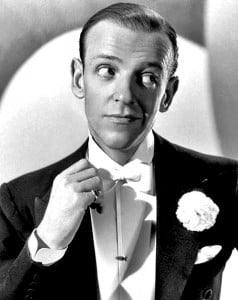Fred Astaire, by Joseph Epstein. New Haven, CT: Yale University Press, 2008. 198 pp. $22 (cloth).
In the light and lively Fred Astaire, author and journalist Joseph Epstein offers an excellent overview of the career of the world’s greatest male ballroom and tap dancer. This short biography, part of Yale University’s Icons of America series, is like its subject—accessible yet elegant.
Astaire began his dance training at the age of five after his mother, Johanna Austerlitz, brought him to New York City in the hopes of grooming him and his talented older sister, Adele, for careers in show business. Attending dance school with his sister, young Frederick took to the art form and was soon rehearsing with Adele in routines developed by their instructor. Changing their last names to “Astaire,” the brother-sister act hit the theatrical circuit and began a professional career that lasted many years and included appearances on Broadway with Al Jolson and Fanny Brice; and work with famed showman Flo Ziegfeld, who paid the duo an impressive $5,000 per week during the Depression (pp. 12, 15).
After Adele retired at the age of thirty-five, Astaire sought fortune in Hollywood. Shortly after being famously dismissed by a studio executive as “Balding. Can’t sing. Dances a little.” (p. 18), Astaire was noticed by Metro-Goldwyn-Mayer (MGM) and signed to a three-week contract for $1,500 per week. His first role—playing himself in Dancing Lady opposite Joan Crawford—proved that he had potential as a screen star (p. 19).
Epstein writes that Astaire was perfectly suited to a particular type of motion picture—the musical comedy—which he describes as a “group of songs and more or less energetic dances strung out over a generally preposterous plot . . . a purely American art form” (p. 45). Astaire practically created the genre—and then dominated it. He matched film to dance with precision, making sure that the camera filmed his entire body, not merely his feet or his face (p. 48). Epstein quotes arts writer Edwin Denby on Astaire’s ability to integrate dance and film:
The dynamic range is narrow but sharply differentiated; the dramatic miming is barely indicated but perfectly intelligible; the presentation is intimately charming; and the dance itself rarely needs much room. A complete dance phrase can generally be photographed close by in a single camera field, and the continuity to the following phrase is generally so casual that a shift in the camera between phrases does not interrupt very much. These are the technical advantages which allow Astaire—who is certainly a great dancer—to give a more complete sense of dance expression on the screen than good dancers in other styles can (p. 143).
Journalist Arlene Croce’s description of a routine with his ballroom dance partner Ginger Rogers from the film Roberta gives the reader a sense of Astaire’s magnificent dancing on screen: “It begins with some light banter punctuated by dance breaks, continues with music and more dance breaks—a tap conversation with each taking eight-bar ‘sentences’ (his growing more impudent, hers more indignant)—and ends in a chain of turns across the floor and a flop into two chairs” (p. 141).
Writer G. Bruce Boyer describes a typical Astaire movie: “nonchalance defeats formality, heritage succumbs to natural finesse, vitality overcomes rigid ceremony, propriety is bested by humor, ritual dignity by legitimate naïveté” (p. 44). With his graceful dancing implanted in everyday stories laced with humor, audiences devoured Fred Astaire movies throughout 1930s, 1940s, and 1950s, particularly those featuring Rogers. Epstein reports that Astaire made enormous profits for the studios and, because he had a stake in his early films such as Top Hat, for himself. Epstein shows that the popular dancer used his box office appeal in order to gain artistic control. Astaire “had a clear understanding of how highly he was valued, and that he could cash this in by insisting on his own performance standards” (p. 76).
Throughout Fred Astaire, Epstein emphasizes the artist’s ability through carefully selected quotes, from an early critic’s remark that the slender dancer “combines eccentric agility with humor” (p. 11), to a tribute by the late modern dance choreographer Merce Cunningham in the New York Times shortly after Astaire’s death in 1987. Cunningham said he enjoyed Astaire’s “wit and play with steps, going slightly ahead of the beat and again delaying to stretch something a fraction . . . the sheer pleasure of his dancing—a quality that makes us lose track of mental gymnastics. It gives the mind a rest and the spirit a big boost” (p. 144). Epstein’s own estimate is equally astute, attributing Astaire’s ability to his hard work, to the pains he took to make his dancing appear to be effortless. And Epstein makes an interesting contrast between Fred Astaire’s approach to dancing and that of another great American dancer: “The chief difference between Gene Kelly and Fred Astaire as dancers is that Kelly is always stressing the arduousness of what he is doing, while Astaire is dedicated to making it all look easy . . . Kelly huffed and puffed, Astaire glided and grinned” (p. 74).
Fred Astaire has its deficiencies. Because Epstein focuses on Astaire’s work in dance-themed musicals, there is nothing in the book about his later roles in On the Beach (1959), Finian’s Rainbow (1968), or The Towering Inferno (1974), for which he received an Oscar nomination. Similarly, there are glaring omissions in Epstein’s coverage of Astaire’s personal life: Little is said about his mother’s influence, his wives and children, or the toll dancing took on his body. And given the book’s coverage of Astaire’s film career, its lack of a filmography is a serious oversight.
Despite these drawbacks, I highly recommend Fred Astaire. It is an entertaining overview of the artist’s aesthetic approach and magnificent career—a short book that takes stock of its subject and expresses, as Epstein sums up the meaning of Fred Astaire, “simple happy bloody joy in living” (p. 175).


![[TEST] The Objective Standard](https://test.theobjectivestandard.com/wp-content/uploads/2017/10/logo.png)














